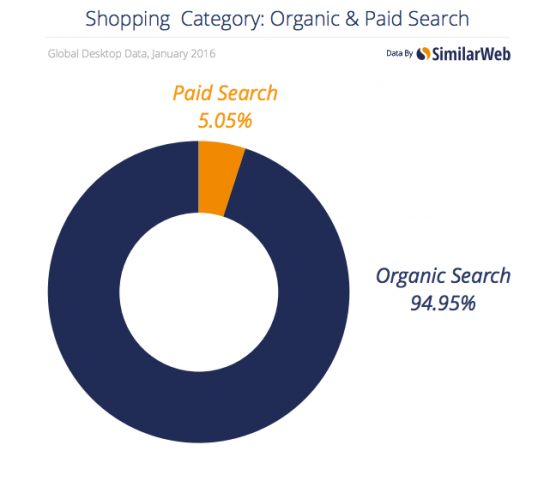For many businesses, the process of divvying up paid and organic search marketing dollars often relies more on gut feeling than science. Since paid appears to offer an easier path to understanding whether you’re getting bang for the buck (you paid this for click, and saw this resulting rise in sales over this period in time), digital marketers typically view paid as the shinier penny.
Not so fast. A March survey from Similar Web found that in the massive global retail shopping industry, organic consumer Google search traffic on desktop delivered 95 percent of all consumer conversions compared to only 5 percent from paid search advertising.
Whaa?? You’re scratching your head on this one, aren’t you?
Lest you think it’s an aberration, the research closely tracks that of a 2012 UK study published by Econsultancy. It found only 6% of clicks were the result of paid listings.
While the definition of conversion here doesn’t necessarily translate into actual sales, the study offers some stark figures for marketers to consider as they debate spending millions on paid ad spends.
Finding the right formula between paid and organic has never been easy.
Organic search results are a search engine’s attempt to closely match listings that are relevant to a user’s search terms. Non-organic, or paid search, are results in which a company pays a search engine provider for preferential access.
Marketers use SEO and content assets to get their web pages to rank for more content topics related to search queries. And unless your SEO webmaster keeps can advise you on how not to fall victim to the latest algorithm changes and any other Google tweaks, hard-fought gains could instantly be lost.
On the other hand, paid results can get you right in front of a searcher, at a time when they may be closer to buying than simply window shopping or gathering information. Yet, placement of the ads is determined by both a bidding process and quality score. What’s more, many studies have shown consumers are less trusting of paid placements than organic results.
Complicating matters further in considering paid, Google recently reconfigured the search engine results page (SERP), eliminating the right rail of ads that coexisted in the same vertical space as organic. The change will effectively increase the cost of each paid ad since the competition for space on the first page will be smaller (imagine taking three of four chairs away in a game of musical chairs).
The right-rail switch-up also could result in fewer organic results appearing near the top of page 1, which means search engine optimization takes on ever-more importance. Google increasingly is using the real estate to serve up what its algorithm believes is the most relevant organic response to a query. It’s expanding upon the knowledge graph with rich answers and featured snippets as well as a “people also ask” box where it deems appropriate.
So what’s it all mean? Brands should be aware that a relatively small amount of effort focused on organic search optimization can yield substantial returns, especially given the increasing importance of various types of rich answers being incorporated into the SERP.
While marketers should still invest in paid search, the calculus for paid advertising and organic search efforts increasingly is requiring an integrated approach. How you structure that will require a great deal of improvisation as Google steps up the pace of change to its algorithms to streamline the look and feel of the SERP. As the company increasingly chooses a mobile-first strategy, it’s highly likely desktop results will come to resemble the changing look of mobile.



